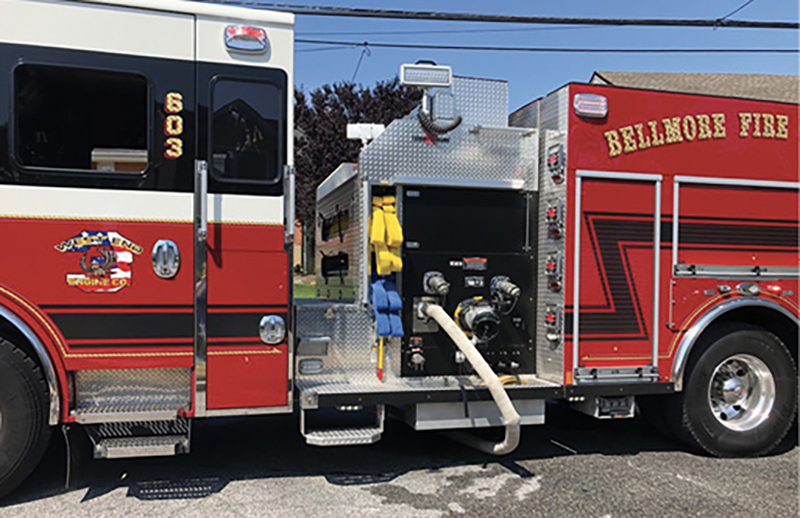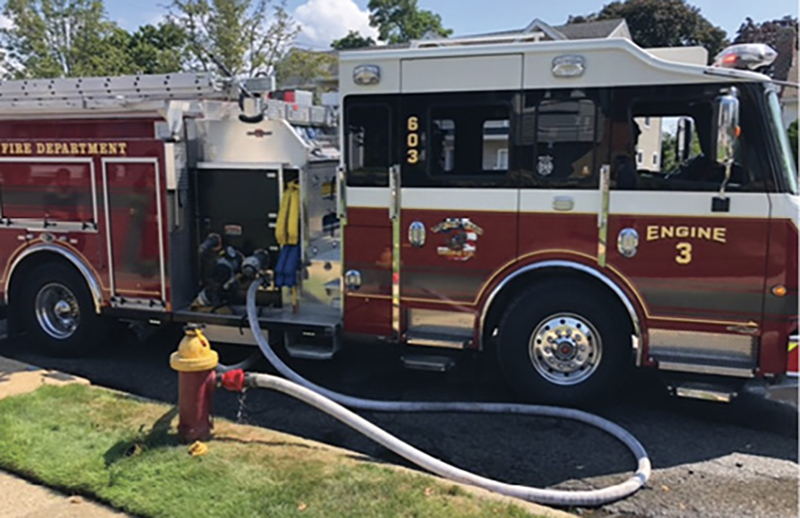The basic and most fundamental task a firefighter, fire company, or fire department must be able to perform is to get water on the fire to extinguish it. Long before radios, self-contained breathing apparatus, hydraulic forcible entry tools, thermal imaging cameras, hazmat meters, technical rescue gear, bunker gear, personal alert safety systems, and horse-drawn fire apparatus, all “able-bodied persons” used buckets to put water on fires. As a national fire service, we have become so good at almost all aspects of emergency services that we’ve gotten away from our prime responsibility—“putting the wet stuff on the red stuff.”
First Due
As an engine company, your one job at a fire is to get water on it in almost any way possible. If you’re the first-due engine, your one and most basic task is to stretch the first line, secure a positive water source, and get water on the fire as fast as possible. That could be by a charged preconnected hoseline, a dead bed stretch, or the deck gun. Quick water includes starting on tank water while waiting for the established positive water source.


(1-2) Every engine apparatus has four sides. Are you and your company capable of supplying and delivering water from each of those four sides? (Photos by author.)
Every engine apparatus has four sides. Are you and your company capable of supplying and delivering water from each of those four sides or do you routinely only use the “front suction” or “rear step”? What if there’s an issue because of parked cars, radiant heat, a tight alleyway, a broken valve/hose/hydrant wrench—you name it? Can you, right now, supply and obtain water from the sides of your engine apparatus?
Nightly, at the fire academies where I teach, we see engine companies from every battalion come out to fight fires only to use the front or rear of the apparatus exclusively. Rarely (unless the instructors make it part of the scenario) do companies use the side intakes/suction inlets. Routines and complacency are two deadly traps firefighters can fall into; don’t let this happen to you. If your fire instructors don’t challenge you, take it on yourself as a senior firefighter, a chauffeur, or an officer to tackle different ways for your company to perform your one job.
Second Due
What if you’re the second-due engine? Your one job is to make sure the first engine company is stretching and operating the first hoseline and that they have or are establishing a positive water source. If they don’t, it is your job to assist them in their one job; this is still your only job as well. Of course, if staffing permits and you can simultaneously assist the first engine and stretch a second hoseline, deckpipe, master stream, and so on, even better! Additionally, ask yourself the following questions:
- Who’s responsible for connecting to the fire department connection (FDC)/siamese for sprinklered or standpipe buildings?
- Do you know the location of the FDC/siamese?
- What size supply line should you use?
- Do you need any fittings or adapters to make the connections?
- What will you do if the FDC/siamese is broken or out of service?
Even if you’re the 14th engine company on a wind-impacted, three-block-radius conflagration in your jurisdiction, your one job is still to get water on the fire, either by relieving an already operating company or establishing a water relay/water shuttle/remote water supply and assisting or getting water to or on the fire.
Mayday! Mayday! Mayday!
As an engine company, what is your responsibility during a Mayday? Have you ever drilled on it? You’ve been trained in firefighter removal. What is your job now? If you’re stretching or operating a hoseline, your one job remains the same.
Give the Mayday firefighter and those attempting to assist him the best chance at success by continuing with your one job. If you happen to be able to assist while still performing or are in the midst of performing your one job and your assistance will keep the fire from growing, then, by all means, do so within your department’s standard operating procedures.
One-Job Issues
Scenario: You’re the backup or third firefighter on the hoseline. The nozzle firefighter calls for water. The line is charged, you see the line swell and yell “Water’s coming,” and you prepare to control the line and the hose stretch. The nozzle firefighter then opens the line to bleed it, and there’s very little water coming out of the nozzle and at extremely low pressure. You may even hear the pumper’s revolutions per minute racing higher and higher. While the nozzle firefighter or officer is calling the pump operator to find out what’s going on, what are you doing? If you’re thinking you’re dropping the line to chase kinks, look for pinch points, or a burst hose length, you nailed it! If you are holding the line, waiting to advance, hoping someone else fixes the problem, you are wrong—dead wrong!
If an engine company’s one job at a fire is to get water onto it, then every engine company firefighter’s job is to make sure that goal is accomplished and done so with the correct size hoseline and nozzle with enough hose to reach the seat of the fire and areas of probable extension with water at the right pressure and correct stream position. If you’re the third, fifth, or 10th firefighter on the line, consider the following questions:
- Did you tell the pump operator how many lengths were stretched?
- What discharge is the line hooked up to?
- Which preconnect line was stretched and what type of nozzle is attached to it?
- What level of the structure will the line be operating at?
- Did you ensure the pump operator is all set and which intake the hydrant supply line is connected to before they call the hydrant firefighter for water?
If the pump operator hears the call for more pressure from the nozzle firefighter or officer and you’re still at the apparatus, do you know how to assist them? Check for kinks yourself by starting at the discharge and working your way toward the nozzle. Hopefully, you’ll run into another firefighter working his way from the nozzle back toward the pumper, where you can both confirm to each other that all kinks have been removed.
Before leaving the apparatus, check the supply line to see if it’s getting water into the pumper or if it is just filling up the hosebed. If you’re trained, ensure the pumps are engaged and that the engine transmission is in “Drive.” If everything is going well and the lines are stretched and operating properly, look for a secondary hydrant, just in case. Also, make sure someone is in contact with the next-due pumper to either get some assistance or cut them loose to do their one job.
Nonfire Emergencies
When you respond to a vehicle extrication/disentanglement; gas leak; carbon monoxide alarm; barricaded, emotionally disturbed person; fuel spill; trench rescue; and so on, what is your one job? It should be the same. Stand ready at the back or side step and prepare to stretch a hoseline or precautionary line. Also, preplan the water source if it becomes necessary. Know where the other apparatus are responding to or staging and whether the engine apparatus is out of the way to let the necessary tools and equipment into the scene, as is necessary. Remember, we can stretch hoselines; they can’t stretch ladders, high-point anchors, or extrication jaws and cutters, and so on.
Can we use a hoseline for people trapped in a collapse, a body of water, or a submerged car or boat? Of course! Although these may be nontraditional roles for us, the hoseline is still our one job, not always just for use in putting out fires. Don’t let any fire critique begin or end with, “Hey, engine, you only had only one job!”
STEPHEN MARSAR, EFO, MA, is a 35-year emergency services veteran and a battalion chief for the Fire Department of New York. He is also a past chief and commissioner of the Bellmore (NY) Volunteer Fire Department. Marsar has a master’s degree in homeland defense and security from the Naval Postgraduate School and a bachelor’s degree in fire science and emergency services administration from SUNY Empire State College and is a two-time winner of FEMA’s National Outstanding Research Award. He also serves on the advisory board of Fire Engineering and FDIC International.

